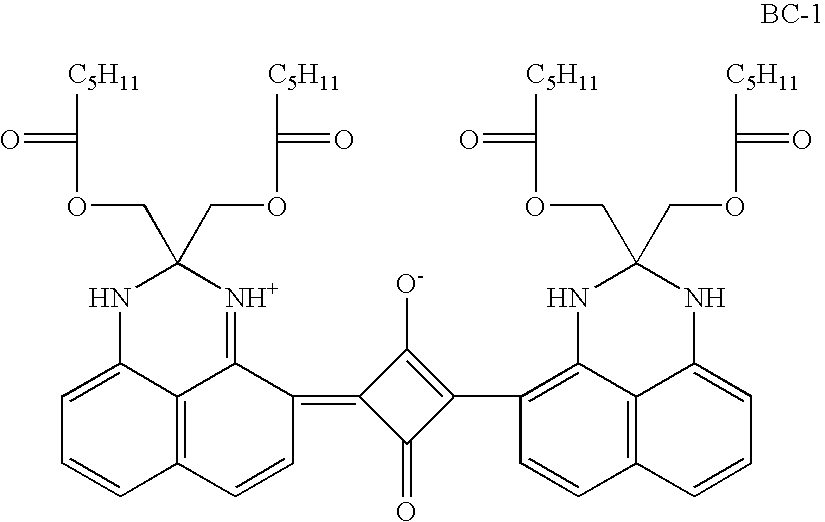Antistatic properties for thermally developable materials
a technology of antistatic properties and thermal development, which is applied in the field of thermal development of materials, can solve the problems of increasing the formation of various types of “fog” or other undesirable sensitometric side effects, distinctly different problems, and much effort in the preparation and manufacture of photothermographic materials, so as to improve the surface resistivity, improve the conductive efficiency, and improve the effect of conductive properties
- Summary
- Abstract
- Description
- Claims
- Application Information
AI Technical Summary
Benefits of technology
Problems solved by technology
Method used
Image
Examples
example 1
Preparation of Conductive Backside Materials
[0274] Conductive Backside Materials were prepared as follows:
[0275] Buried Backside Conductive Layer Formulation:
[0276] A buried backside conductive layer formulation was prepared by mixing the following materials:
[0277] Solution A:
[0278] Solution B:
CELNAX ® CX-Z641M 80 g(containing 60% non-acicularzinc antimonate solids in methanol)MEK120 g
[0279] Solution A: VITEL® PE-2700B LMW and CAB 381-20 were dissolved in 1269 g of MEK.
[0280] Solution B: CELNAX® CX-Z641M non-acicular zinc antimonate was placed in a second reaction vessel, stirring was begun and 120 g of MEK was added.
[0281] Buried Backside Layer Solution: Solution A was added to Solution B with stirring.
[0282] Backside Overcoat Formulation:
[0283] A backside overcoat formulation was prepared by mixing the following materials:
MEK88.88 weight %CAB 381-2010.98 weight %SYLOID ® 74X6000 0.14 weight %Antihalation Dye BC-1 0.07 weight %
[0284] The buried backside conductive lay...
example 2
Preparation of Photothermographic Materials
[0294] Backside conductive carrier layer and backside overcoat layer formulations were prepared, coated onto a 7 mil (178 μm) blue tinted poly(ethylene terephthalate) support, and dried as described above in Example 1.
[0295] Photothermographic Emulsion Formulation:
[0296] A photothermographic emulsion coating formulation was prepared using a silver salt homogenate prepared substantially as described in Col. 25 of U.S. Pat. No. 5,434,043 (noted above), incorporated herein by reference. The photothermographic emulsion formulation was then prepared substantially as described in Cols. 19-24 of U.S. Pat. No. 5,541,054 (Miller et al.) that is also incorporated herein by reference.
[0297] Photothermographic Emulsion Topcoat Formulation:
[0298] A topcoat formulation was prepared for application over the photothermographic emulsion formulation with the following components:
MEK86.10 weight %VS-1 0.35 weight %Benzotriazole 0.27 weight %Silica 0.21...
PUM
| Property | Measurement | Unit |
|---|---|---|
| thickness | aaaaa | aaaaa |
| thickness | aaaaa | aaaaa |
| thickness | aaaaa | aaaaa |
Abstract
Description
Claims
Application Information
 Login to View More
Login to View More - R&D
- Intellectual Property
- Life Sciences
- Materials
- Tech Scout
- Unparalleled Data Quality
- Higher Quality Content
- 60% Fewer Hallucinations
Browse by: Latest US Patents, China's latest patents, Technical Efficacy Thesaurus, Application Domain, Technology Topic, Popular Technical Reports.
© 2025 PatSnap. All rights reserved.Legal|Privacy policy|Modern Slavery Act Transparency Statement|Sitemap|About US| Contact US: help@patsnap.com



